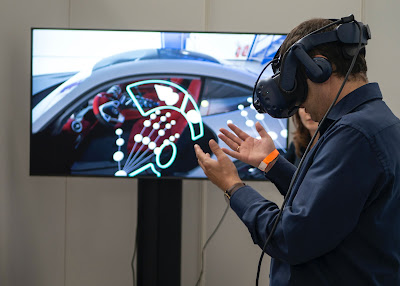Discovering Binaural Audio
Binaural audio uses loudspeakers, which are common listening equipment, along with a number of psychoacoustic techniques to simulate the sound of many directions.
How does that work, and how might a customer feel it?
Immersive audio must first be mixed. There are several ways to accomplish this, but using an "intermediary" structure is often the most well-liked. This enables the decoding of an immersive mix to any system, like 5.1, 7.1.4, or stereo.
A channel-based strategy is one way to accomplish this. Ambisonics, which is extremely common in the realm of professional audio, is an illustration of this. Despite its entrance into the game industry, you won't hear much about it from consumers. A fixed number of channels, usually four or sixteen, are used in this open format to indicate the directionality of various sounds.
These channels can be decoded into any format, including the immersive formats we've been discussing or even just stereo, using a "matrix," which is really just a fancy word for a series of mathematical calculations.
Object-based formats like Dolby Atmos, DTS X, and Auro 3D are becoming popular among consumers. Each sound in a mix can be specified as an object and given precise coordinates in a 3D environment, which can also vary, allowing the object to move around in space, as opposed to being encoded into a channel matrix.
This method has the benefit of generally translating better to various playback platforms.
The object-based approach, in our opinion, provides superior "localization," making it simpler to determine where sounds are coming from. The drawback of object-based formats is that there are restrictions on the number of objects that can be used. The cap for atoms is 128. It is still a hard restriction, despite the argument that it is more than adequate.
So now that we have a nice, sophisticated Dolby Atmos mix, how does that sound on headphones?
As I mentioned previously, there are numerous tricks that can be employed. An "HRTF," or head-related transfer function, is what's known as it and contains the majority of those.
Special models known as HRTF are used to explain how the human head and ear respond to sound. Based on which ear a sound initially enters and how our head and external ears shape the sound, we can pinpoint a sound's location when we hear it. We have a feeling of direction from this. These effects can be referred to by a number of names, including the pitch height effect, interaural time difference, and interaural level difference.
However, I would like to rapidly point out that there is a drawback to HRTF, namely that everyone has ears and heads that differ significantly from one another, which alters how we localize sound. The great majority of immersive audio technologies use generalized HRTF, which approximates the human head on average and may not be as accurate for all users.
However, because of the complexity required, some tools, like Sony 360, can use custom HRTF that precisely imitate an individual's ears and change depending on the listener. In the instance of Sony 360, they utilize AI software to compare a picture of your ear to a model of an ear in their database.
Binaural audio and HRTF often tie the soundfield to your head, so keep that in mind. This implies that, unlike how sound functions in the actual world, the 3D sound image moves along with you as you turn your head. Localization and immersion may be affected by this.
A VR headset tracks your head motions and maintains the sound image in the same location as you move your head, which solves this problem in the world of VR gaming. Other head tracking options, like the Waves NX Head Tracker, don't demand a large headset. There are head trackers incorporated into some headphones, such as the Bose QC 35, and there are even gadgets that need you to attach your phone to your head in order to use it as a head tracker. But now that you are aware of everything.
How exactly does the typical consumer experience these "virtually surround" methods?
Well, there are numerous options. They will be divided into two groups: decoded audio and encoded audio.
You receive audio that has been decoded in binaural format. Audio that has been encoded and can be converted to binaural on your end comes in formats like Dolby Atmos. Decoded audio is very simple to find. Since binaural audio just has two audio channels, it can be used anywhere that supports stereo audio.
A stereo or mono mix is simply shifted around a 3D sound field using binaural techniques to create so-called "8D audio," by the way. Since the binaural picture is "baked in" to the audio, these decoded methods have the disadvantage of lacking some of the more advanced characteristics of binaural audio, such as bespoke HRTF and head tracking.
I'll move on to encoded formats, which are widespread. You'll encounter numerous other formats, including DTS X, Auro 3D, and Dolby Atmos. These formats are often associated with a particular type of distribution, such as a video game, a music streaming service, or a film. Binaural audio is available on a variety of music streaming sites. Deezer, Tidal, and Amazon Prime Music are a few instances.
Sony 360 and Dolby Atmos are the two most popular formats in this area. Unfortunately, access to these formats is currently limited. Usually, they need a phone, or in Amazon's case, an Echo gadget. Some app experiences are only accessible to IOS or Android users, or even to certain phone models.
Things are a bit better in the realm of video games and movies. As 3D environments are already the foundation for gaming audio, immersive audio usually works incredibly well with it. Some video games use these strategies right out of the gate; Senua's sacrifice from Hellblade is one of my favorites.
Some let you choose whether to enable it while playing, while others can be made to do so by using third-party plugins. Tools like DTS Sound Unbound, Windows Sonic for Headphones, and Dolby Atoms for Headphones are useful in this situation. Binaural audio is created using a surround sound stream.
The same applies to television programs and movies that have been blended for surround sound. Normally, a receiver is needed to decode surround sound audio for visual media, but in this instance, the software accomplishes it. To enable these features in Windows, simply right-click on the volume control and choose "Spatial Sound."
Although Windows Sonic is included in the box, in my opinion, it's quite terrible. Dolby Atoms is considerably better, but after a brief trial, you must purchase it. Having said that, if you like this kind of thing, I believe the price is quite worthwhile.
Which of the other formats is there?
Virtual surround headsets, which formerly generated a lot of hype in the gaming industry, are the major ones. Because you can use software to experience this thing on any set of headphones, they've largely lost popularity and receive little coverage.
Virtual surround is really difficult overall. Not because the idea is bad; it's actually extremely simple, really cool, and it works. The issue is that there are numerous formats and fixes for these procedures, but the final product hardly differs from these.
It can be frustratingly difficult to figure out how to convert your favorite material, whether it be music, movies, or video games. The constant introduction of new formats and methods is not helpful.
The PS5 now uses Sony's "Tempest" audio engine, which is the newest significant one. Overall, Tempest really doesn't offer all that much more than other options like Atmos; it's just one more format for enjoying virtual surround. In the future, I hope spatial sound becomes much more widespread and available, but for the time being, the key is to sift among the available options to find one that meets your needs.
Finally, though, this piece has clarified some of that and simplified a few things for you.





_11zon.png)

No comments:
Post a Comment